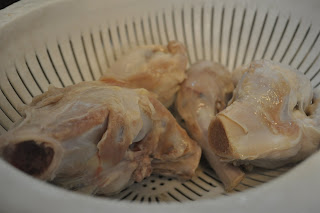While an introductory blog post is still in order, I begin this work upon receiving a copy of "The French Laundry Cookbook" (FLC for short) by none other than
Lauren Dodge. This in depth work by Thomas Keller, one of the masters of modern American cuisine, inspires to me to try to replicate these recipes (and many others) and keep a public record. The successes, the failures (mainly failures), and and horrendous messes will be available for all to see.
Today, I decided to cook a (relatively) simple but delectable recipe from the FLC --- Moi with Soy beans, Scallion and Radish Salad, with a Soy-Orange glaze. Of course, to my dismay Central Market did not have moi, nor fresh soy beans (nor the logical substitute, fava beans), so I substituted grouper per recommendation of the fish monger and fingerling potatoes instead of the soy beans. I'll gladly accept the grouper substitute, but I hope the addition of the fingerling don't cause the dish to stray too far from its Asian influences.
Now.. grouper. Quite an
ugly fish, but luckily attractiveness is not reflective of taste. The fish was excellent. It was not flaky, which is usually my favorite aspect of a fish. Instead, it was 'full-bodied', if that makes any sense. Meaty. Also, worked very well with the sweet tang of the soy-orange glaze.
How does one go about this dish? Particularly, how does one cook a dish which is on the menu in arguably the best restaurant in the world in a kitchen the size of a thimble? Very carefully:
Grouper with Fingerling Potatoes, Scallion Radish Salad, and Soy-Orange Glaze:
There are four main components (plus one that I added for S&G).
1. Grouper.
2. Scallion-Radish salad
3. Fingerling potatoes.
4. Soy-Orange glaze
5. Carrot Powder.
Let's address each in turn. The following serves 2.

Grouper: This will really be the last step. Pat two fillets of fish dry and season with salt (you always hear about seasoning with salt and pepper, but the pepper really never does it for me). Cook over medium heat in oil (canola in this case) 2 minutes first side, 1 minute second side -- this will give you a nice rare fish (does one use 'rare' when describing fish? oh well). When done, transfer immediately to the plate.
 |
| Juliened radishes, carrots, and scallions. |
Scallion-Radish Salad: Julienne (cut in really, really thin strips) about 1-1.5 tablespoons each of carrot, green onion, and radish (this is probably the most time consuming step). When done, put in ice bath to retain crisp freshness, and as Keller suggests, so the green onion will curl up and hold salad together in the end (I found this not to be true). When ready to serve, remove from ice bath, dry with paper towels, and mix with a bit of olive oil and lemon juice.
 |
| Tomato diamonds!? First time for everything. |
Fingerling Potatoes: Boil 6 potatoes for ~20-30 minutes in salted water (a fork should have very little resistance going in). When done, cut in half lengthwise and saute with 1 tbl butter, 1 tablespoon diamond tomatoes (!?) and 0.5 tbl brunoise (diced carrots, turnips, and leeks which are quickly blanched individually in boiling water then ice bathed) + salt to taste.
Soy-Orange glaze: Take 1 cup of good OJ and reduce over medium heat till you have 0.3 cups (you want something that will coat the back of a spoon). Keep warm. When about ready to serve, mix in 1 tbl of cold, unsalted butter 0.25 tbl at a time, then a good dash of soy sauce to taste (about 0.5 tablespoons).
Carrot Powder: Microwave a really tiny dice of one carrot for ~ 10 minutes over low (FLC said 40 minutes... I found it to be nowhere near that). Put these dehydrated carrot pieces in a coffee grinder or spice grinder until you have a powder. This is actually a really neat technique that one can do with a huge variety of ingredients.
Great -- now assembly. Put soy-orange glaze on plate. Fingerling potato on top of that. Grouper on that. Scallion radish salad on that. It should loosely resemble a tower of sorts. Sprinkle the carrot powder artistically on the side of the plate and serve immediately.
 |
Finished product. Eating took approimately 1/200 of preparation time. |
|
|
End result? Really, really, really good. The fish, cooked perfectly, went splendidly with the tender potatoes, with the (perhaps too) sweet soy-orange glaze really bringing everything together wonderfully. The scallion salad on top was the star of the dish, lending an cold-crunchy-citrusy bite that the dish would have been woefully missing otherwise. Strangely, the last bite was the best, when every component of the dish was bound together by the delicious glaze. The carrot powder, while interesting, didn't really bring much to it though. And those tomato diamonds? I didn't really notice them...
There was one thing I did miss though. After living in Texas for ~ 3 years now, I've come to love heat in dishes. If, after you finish a meal, your mouth is not still reminding you that you just ate something hot, something is wrong. Heat is just not too common in French foods. The above dish, while amazing, had no heat, no spice, no fire to it. The scallion salad on top would have been the perfect place for some julliened spicy thai peppers perhaps... or possibly some cayenne in the soy-orange glaze. I have a feeling I will be adding fire to many of these dishes that I so desperately crave.
Next time... veal stock.



























